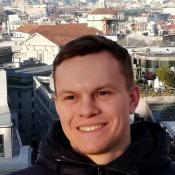Theoretical seminar | 18 November 2020
begins at
18 November 2020
12:00 PM (GMT +03:00)
location:
Online
Ru

Mr. Nikita Olekhno
ITMO University
Topological and entangled states of light in nanostructures [based on the materials of PhD thesis]
Every week we will send you an e-mail with a digest of scientific events. Subscribe and wait for an e-mail!
Abstract
'Topological and entangled states of light in nanostructures' [in Russian, based on the materials of PhD thesis]
Topological states of light in quantum and nonlinear photonics remain less explored compared to the classical and linear photonic systems due to the increased complexity both from the theoretical and experimental sides.
In the present talk, I address photonic systems that are quantum and nonlinear simultaneously. First, we consider the generation of entangled surface plasmon-polariton pairs due to the spontaneous parametric down-conversion of light by a nonlinear nanoparticle. Next, we study the formation of topological edge states of interacting photon pairs in arrays of coupled resonators, including theoretical studies as well as the experimental emulation of such states with electric circuits. In the following, a more general case is considered, when the resonators are coupled to a waveguide, which leads to the long-range couplings and the emergence of new localized phases of photon pairs. Finally, the obtained results are further applied to describe the formation of higher-order topological states in two-dimensional Su-Schrieffer-Heeger models realized with the arrays of photonic resonators.

Ms. Natalia Kostina
ITMO University
Optical manipulation of nanoparticles using surface waves of the substrate [based on the materials of PhD thesis]
Every week we will send you an e-mail with a digest of scientific events. Subscribe and wait for an e-mail!
Abstract
The interaction of light with nanoscale particles can provide stable trapping, control of movement, and formation of ordered arrays of particles. Controlling the position of subwavelength objects using light has found many applications, such as fabrication of nanostructures, particle sorting for biomedical applications, microelectronics, and others.
In the case of optical manipulation near a substrate that supports surface or volumetric propagating modes, several advantages can be revealed due to additional degrees of freedom introduced into the system. Here, we consider the effects of optical pulling force and transversal optical binding induced by auxiliary substrates. The contribution of different types of substrate modes is analyzed via Green’s function approach. It is shown, that plasmonic substrates, hyperbolic metamaterial substrates, and one-dimensional photonic crystals provide versatile optomechanical positioning of the particles and can lead to self-arrangement of the particles under plane wave illumination (optical binding) in arrays with subwavelength periodicity.
Last news
-
-
Scientific Show, Lectures, and Lab Tours: Recap of Physics Day 2025 at ITMO
-
ITMO-Developed Metasurface Makes Optical Chips 2x More Efficient
-
“Combing” Light: ITMO Researchers Find Reliable and Fast Way to Transmit Data in Space
-
ITMO Researchers Produce Artificial Optical Synapse for Enhanced AI Performance
